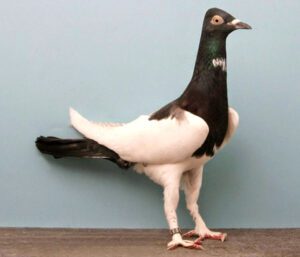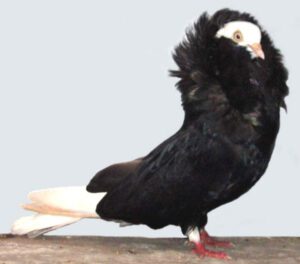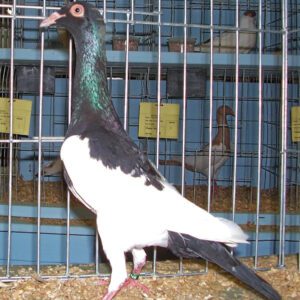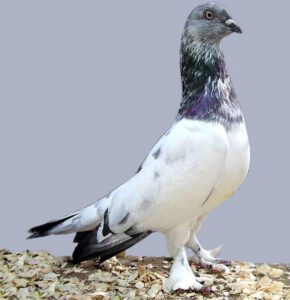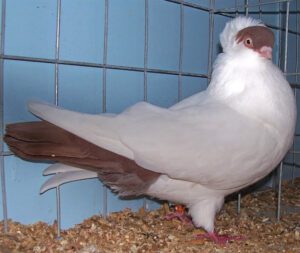The Ice pigeon (also known as Ice Pouter pigeons) is a breed of domestic fancy pigeon from Germany. It is known as Polish: Lazurek and German: Eistaube. It is one of the oldest of the German color pigeon breeds and was developed over many years of selective breeding.
The breed is actually from the South Germany. And it was first developed in the region from eastern Germany to western Poland, with most early breeding in Saxony and Silesia.
The Ice pigeon and other varieties of domesticated pigeons, all are descendants from the wild or feral rock pigeon. In 1856, Charles Darwin is known to have crossbred the Ice pigeon in order to ascertain color patterns.
This work came just three years before his groundbreaking publication, On the Origin of Species. It’s a feather footed breed from Saxony, Silesia and Lausitz. The checkered Ice (Forellen) were developed in Silesia and South Germany.
These pigeons are very beautiful birds with calm and gentle nature. They are very good for exhibition and ornamental purpose, and also very good for raising as pets. It is a fancy pigeon breed and raised mainly for exhibition purpose. However, read more information about this pigeon breed below.
Origin And History Of Ice Pigeon
Ice pigeons are believed to have originated in Germany in the 19th century. They were created through selective breeding from various other breeds of domestic pigeons, including the German Pouter and the Cumulet.
The goal of breeding the Ice Pigeon was to create a bird with a distinct appearance and behavior, characterized by a unique puffing out of the crop, or the throat area, during courtship displays.
The name “Ice” refers to the bird’s striking coloration, which is predominantly white with black or blue markings. Today, Ice pigeons are popular show birds and are admired for their striking appearance and distinctive behavior.
Characteristics
Ice pigeon is an average sized bird which is named and known for it’s ‘ice-blue’ coloration. It’s head is slightly oblong, and have smooth head. It has several varieties, which are differing in the type and color of their wing pattern. But the basic color of these birds is a pale grey.
Eyes of these birds are of different color depending on the variety. The black barred and checked version has orange to yellow orange colored eyes. And all other varieties have black eyes.
Neck of the Ice pigeon is of medium long and gently forward stretched. The beak is medium to long and slender and dark in color.
Chest of these birds is broad and deep, and forward stretching. They have long wings which are resting on the tail, and their back is broad between the shoulders and then gently sloping down and narrowing towards the tail.
Their tail is long and well closed, and the legs are tight fitting and feather rich but not excessively long on the muffed. And there is also a clean legged variety of the Ice pigeon. Photo and info from Wikipedia.
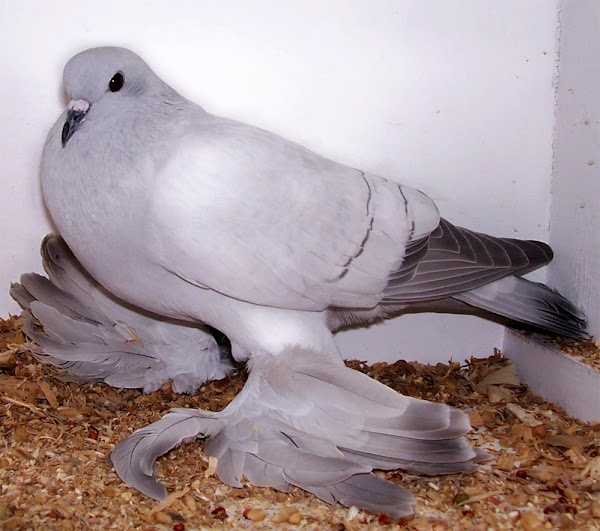
Housing
Arranging good housing facilities for your pigeons is a very important. So, try to arrange a good house or shelter for your birds. You can also purchase ready-made cage from the market, if you already don’t have the shelter ready.
Ice pigeons require enough space to move around freely and engage in natural behaviors, such as flying and perching. Ideally, they should be housed in a large aviary or loft that allows them to spread their wings and fly. The minimum recommended size for a loft is 8 feet by 8 feet, with a height of at least 6 feet.
Ice pigeons require nesting areas where they can lay eggs and rear their young. Provide nesting boxes or baskets in a secluded area of the loft to encourage breeding behavior. It is recommended to provide one nesting area for every pair of pigeons.
Feeding
This is another most important part of pigeon farming business. Good and nutritious food helps the birds to stay healthy and grow better. Like many other pigeon breeds, you can also feed your Ice pigeons with wheat, maize, paddy, rice, enamel, legume, mustard, gram etc.
Try to feed at least twice a day, or keep food inside their shelter if you raise a few number of birds. Also provide them with enough clean and fresh water as per their demand.
Commercial pigeon feed is readily available and provides a well-balanced diet for your Ice pigeons. Look for a feed that is specifically formulated for pigeons, as it will contain the appropriate balance of nutrients, vitamins and minerals that they need.
In addition to commercial feed, it is recommended to provide supplemental feed for your Ice pigeons. This can include grains such as corn, wheat, barley and millet, as well as seeds like sunflower and safflower. Fresh fruits and vegetables, such as lettuce, peas, and apples can also be included in their diet.
Fresh, clean water should always be available for your Ice pigeons. Change their water daily and ensure that it is free from debris and contaminants. In hot weather, consider providing a shallow water dish for them to bathe in, which can help to cool them down.
Breeding
Ice pigeons are excellent breeders, and they will breed easily if you keep them in pair. Arrange a good nesting box for them and let them get alone, and they will do their job. Select healthy and genetically diverse breeding pairs. Pairs should be at least one year old and in good physical condition. Consider their physical appearance, temperament, and genetic history when choosing pairs.
Ice pigeons typically breed in the spring and summer months. During this time, provide the breeding pairs with a nesting area, nesting material, and a comfortable environment to encourage breeding. The ideal breeding temperature for Ice pigeons is between 65-75 degrees Fahrenheit.
Ice pigeon eggs take approximately 17-18 days to hatch. The eggs should be incubated in a warm and humid environment until they hatch. A commercial incubator can be used, or the eggs can be placed under the breeding pairs for natural incubation. Monitor the eggs closely during incubation to ensure they are developing properly.
Once the chicks hatch, they should be kept warm and protected in the nesting area. Feed the chicks a high-protein diet, such as pigeon feed or soft foods, to promote healthy growth and development. The chicks should be kept with their parents for at least 4-6 weeks before they are weaned.
Caring
The Ice pigeons are excellent, and they are very hardy. They generally require less caring and other management. Although, taking additional caring will help them to grow well and stay healthy. So, try to take good care of them. Monitor their health on a regular basis for any signs of health problem, and ask veterinarian if you notice anything wrong.
Uses
Ice pigeon is a fancy pigeon breed. It is raised for exhibition and ornamental purposes.
Special Notes
The Ice pigeon is a very beautiful bird with calm and gentle nature. It is very good for exhibition and ornamental purpose. And also very good for raising as pets. However, review full breed profile of this breed in the following chart.
| Breed Name | Ice |
| Other Name | Polish: Lazurek; German: Eistaube |
| Breed Purpose | Exhibition, ornamental, pets |
| Special Notes | Beautiful, calm and gentle in nature, good for ornamental purpose, good for exhibition, good for raising as pets |
| Breed Class | Small to medium |
| Climate Tolerance | All climates |
| Flying Ability | Average |
| As Pets | Good |
| Color | Many |
| Rarity | Common |
| Country/Place of Origin | Germany |
Frequently Asked Questions (FAQ)
The Ice pigeon is a very beautiful and friendly breed of domestic pigeon from Germany. It is a pretty old breed which was developed in the 1850s. It is a fancy pigeon breed and also raised as pets. People are asking some questions regarding this excellent pigeon breed. However, here we are trying to list the most common questions about this breed and trying to answer them. Hope you will find your answer. Don’t hesitate to ask us if you have more questions.
Where do ice pigeons live?
They were actually developed in Germany. But today, they are available in many countries around the world outside of it’s native place.
What is the price of ice pigeon?
$100 to several hundreds or even thousands. Exact price depends on numerous factors, and can widely vary from place to place.
What to feed the ice pigeons?
Like many other pigeon breeds, you can also feed your Ice pigeons with wheat, maize, paddy, rice, enamel, legume, mustard, gram etc.
How do you breed ice pigeon?
Arrange a good nesting box for them and let them get alone, and they will do their job.
How long do ice pigeons live?
Average lifespan of these pigeons is around or up to 10 years.
What is so special about ice pigeons?
They are very beautiful and very good for show, they are friendly with humans, and breeding them is extremely easy.
What are the color varieties of ice pigeons?
The basic color of these pigeon is a pale grey. They appear even lighter due to their abundant powder down, which covers the entire plumage in whitish dust.
Is ice pigeon good as pets?
YES, they are very friendly with humans and very good as pets.
Any ice pigeon for sale near me?
Not sure! Please search your local online classified websites.
What is the scientific name for ice pigeon?
Scientific name of this pigeon breed is ‘Columba livia domestica‘.
What about ice pigeon flying?
YES, these pigeons are moderate flyers.
What are the main characteristics of ice pigeon?
Beautiful, calm and gentle in nature, good for ornamental purpose, good for exhibition, good for raising as pets.

